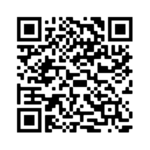Worrying is a state of mind in which you have a lot of thoughts of a negative nature about either potential or actual problems. You can worry about all kinds of subjects, but also about what is causing you to worry: why am I worrying so much? And about the consequences: all this worrying is going to drive me crazy! You may feel like you are stuck in negative thoughts and no longer know how to get rid of them. You can, for example, be convinced that you are not able to manage the worry and that you no longer have control over the worrying. If this is the case, a worry delay experiment can be performed in consultation with your professional.
The purpose of a worry delay experiment is to find out whether worrying can be delayed. You will investigate whether the worrying is manageable and can be controlled.
Exercise:
- When you start to worry, write down the topics you are worrying about.
- Next, postpone your worrying to another moment (for example, at 7 pm, but not right before going to sleep). Try to find a way to remind yourself of the ‘worry period’.
- At the agreed time, recall the topics you wrote down. Investigate whether it is still necessary to worry about these topics.
- Worry about the topics you still want to worry about for a maximum of half an hour.

Source:
Keijsers, G. P. J., Van Minnen, A., Verbraak, M., Hoogduin, C. A. L. & Emmelkamp, P., (2017). Protocollaire behandelingen voor volwassenen met psychische klachten.
Keeping a diary focused on your illness anxiety can help you understand and get insight into the anxious thoughts you are having at any given time and how to manage them.
When keeping a diary focused on your illness anxiety, you can answer the following questions:
- What have you experienced today?
- What thoughts have you had that made you anxious?
- How strongly did you believe the anxious thoughts you had today?
- How much time did you spend on other things today (i.e., not on your body or health)?
- How many times have you asked for reassurance?
- How many times have you checked (e.g., researched) the thought?
- How many times have you ignored the thought?
Fill out how anxious you felt today beneath “What do you feel?”.
Below, you can see a completed example of an illness anxiety diary:
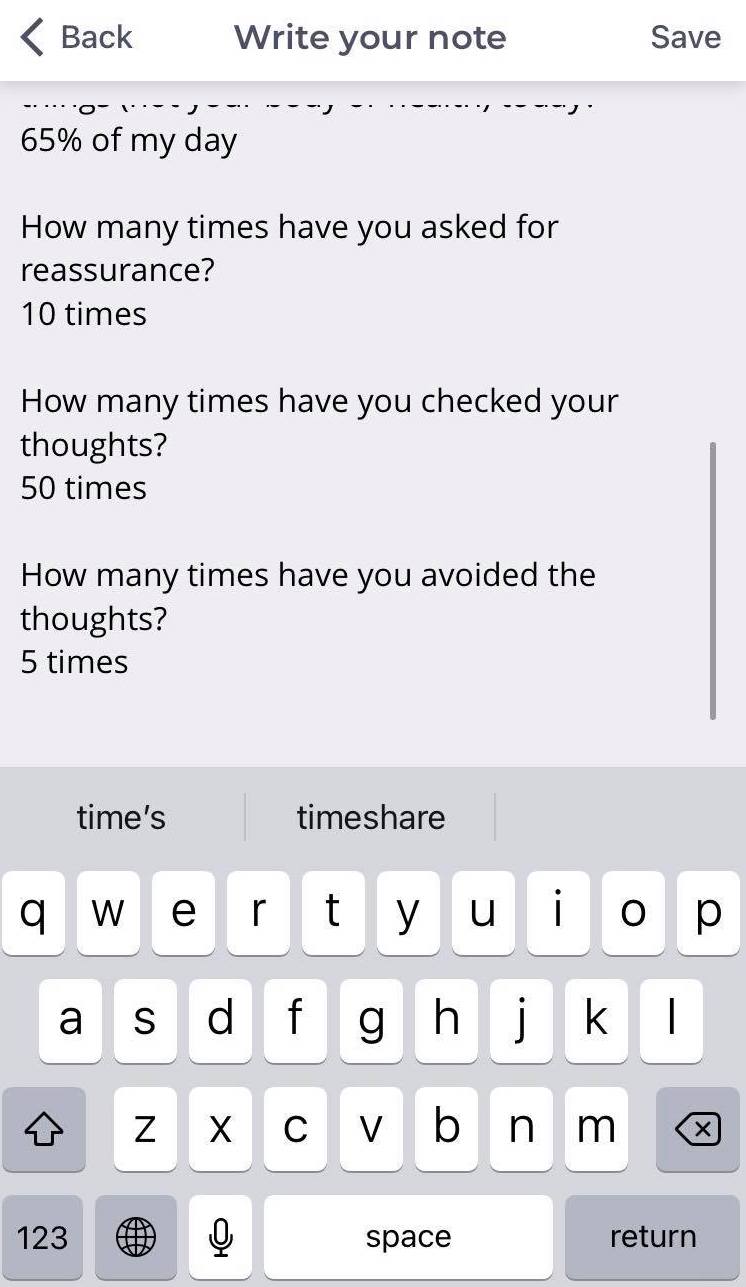
Source:
Keijsers, G. P. J., Van Minnen, A., Verbraak, M., Hoogduin, C. A. L. & Emmelkamp, P., (2017). Protocollaire behandelingen voor volwassenen met psychische klachten.
Intrusions or intrusive thoughts are thoughts that suddenly come to mind. People without OCD also have intrusive thoughts and they are very normal. These intrusions often do not evoke fear in people without OCD. Below, you can read some of the common intrusions.
The thought…
- of being intensely angry with someone related to a previous experience.
- that a loved one has been in or will have an accident.
- that a close friend or family member develops a serious illness or dies.
- of violent acts during sex.
- of harming children or accidents happening to children.
- that the chance of being a victim of a plane crash is reduced if a family member is involved in an accident.
- that there are small asbestos particles in the house, which could seriously harm the family.
- that something serious happened to your partner.
- that you will have an accident or breakdown when you are about to travel.
- that someone will disappear from the face of the earth or the wish for that to happen.
- of ‘unnatural’ sexual acts.
- that someone you know is hurt or harmed or the wish or idea that this should happen.
- of experiences from years ago during which you were embarrassed or humiliated.
- that you could do something dramatic, like rob a bank.
- of physically punishing a loved one.
The anxious thought of suddenly giving in to the impulse…
- to hit or harm someone.
- to say something mean or destructive to someone.
- to attack someone physically or verbally.
- to yell and swear at someone.
- to harm (small) children or be violent towards them.
- to cause a collision with the car.
- to attack and/or violently punish someone, such as throwing or pushing a child out of the bus.
- to attack certain people.
- to push other people away or to push them out of a crowd, for example, out of a queue.
- to say inappropriate or misplaced things, or wrong things at the wrong time.
- to make sexually explicit comments to attractive people.
- to violently attack and murder someone.
- to jump from the roof of a tall building, mountain or cliff.
- to assault someone.
- to say gross and unacceptable things.
- to perform certain sexual acts associated with pain for the partner.
- to jump off the platform when a train arrives.
Source:
Keijsers, G. P. J., Van Minnen, A., Verbraak, M., Hoogduin, C. A. L. & Emmelkamp, P., (2017). Protocollaire behandelingen voor volwassenen met psychische klachten.
Beliefs about your own thoughts – or, actually, thoughts about thoughts – are called metacognitions. These cognitions can be both positive and negative. For example: “Worrying helps me to be well prepared”, but also: “If I don’t stop thinking, I’ll go crazy!” Or “I shouldn’t think about that other man/woman”.
When you have negative thoughts or beliefs, for example about the uncontrollability of worrying, this is also called meta-worrying. In other words, worrying about worrying. For example: “I really have to stop worrying now, otherwise I won’t be able to sleep and then I’ll stay tired!” Or “I keep thinking about everything I do wrong, I really have to stop thinking now!”.
Negative metacognitions and meta-worrying are both at the root of Generalized Anxiety Disorder because they result in an increase in anxiety and worry. To gain more insight into your complaints, you can complete the metacognitive model together with your professional. The model looks like this:
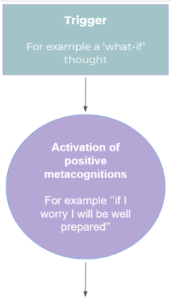
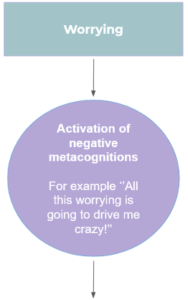

Source:
Keijsers, G. P. J., Van Minnen, A., Verbraak, M., Hoogduin, C. A. L. & Emmelkamp, P., (2017). Protocollaire behandelingen voor volwassenen met psychische klachten.
What is an anxiety disorder?
If someone is struggling with an anxiety disorder, their level of anxiety is not representative of what the person is afraid of. For example, someone may suddenly be very afraid of going out to run a simple errand. This will cause the person a lot of suffering every day, for example because he or she starts to avoid things. However, avoidance perpetuates the fear. This can cause someone to fall into a downward spiral, causing him or her to experience more and more anxiety with more and more things.
What does someone with an anxiety disorder feel?
An anxiety disorder is a disruption of the natural fear response. During a fear response, your body prepares to flee: your heart rate goes up, more oxygen flows to your brain and your muscles tighten. You may sweat more and your body can begin to tremble. With an anxiety disorder, someone will suffer from a fear reaction much more often or more intensely, even in situations where such a fear reaction may not be necessary at all. As a result, the body cannot recover properly and they can feel stressed, tense and fatigued more often. This leads to small things, such as visiting friends, costing a lot of energy. This may cause the person to avoid these types of activities and consequently increases their anxiety.
What can you do?
- Provide a listening ear and show understanding.
- Ask what you can and cannot help someone with. Does someone need involvement or distance? Discuss where the boundaries lie and do not take on too much without consultation.
- Read more about anxiety disorders so that you are better able to understand the other person’s situation. Information can be found in the anxiety library or on the MIND OR Thuisarts
- Support without judgment or disapproval. Try to do this with patience and warmth. Encourage and stimulate the other in an understanding way.
- Realize that the other has and must keep control. Do not exert too much pressure and do not take control, that is counterproductive.
- Do not push them too far when it comes to things they want to avoid.
- Do not try to downplay the other person’s fear.
- There are ways you might be able to help with the treatment, to help with your family’s/friend’s recovery. The professional can give advice on how to do this. Always know your own limits; you are not the professional!
- Try to remain positive towards your loved one with psychological complaints, for example by pointing out things that are going well.
What not to do:
- Don’t try to criticize or give advice. This can make someone insecure.
- Try not to apply pressure when the other person is not ready for it.
- Do not try to tell him/her what is wrong with him/her or what he/she is doing wrong.
Take care of yourself
Be careful not to overburden yourself in caring for the other. Get plenty of relaxation, fun and find a place to vent. It can be nice to talk to people who are going through the same thing; this is called contact with fellow sufferers and, for example, can be done through the Angst, Dwang en Fobie Stichting. If it becomes too much for you, consider seeking (professional) support yourself.
Sources:
- Psyned
- Emergis
- Mind
- Manja de Neef, Negatief Zelfbeeld, BOOM
- Thuisarts
Beck’s Cognitive Model is a model that assumes that psychological complaints arise from the way in which information is selected, interpreted and processed. This process starts early in childhood and is influenced by many factors.
The model describes the following elements:
- Experiences: Relevant learning moments from the past.
- Beliefs:
- Core beliefs are beliefs about how you view yourself or others and your perspective on the world or future.
- Conditional beliefs are beliefs with an “if…, then…” nature. If A happens, that’s the condition for event B.
- Instrumental beliefs can be seen as ‘rules of life’. It is an important value to someone.
- Attitudes: The least profound reaction, such as assessing a particular situation to be undesirable.
- Strategies: A response to the beliefs, the techniques a person develops to survive in life. These can also reinforce our beliefs.
- Critical event(s): A situation that is perceived as problematic.
- Activation of dysfunctional beliefs: During a critical event, a certain cognitive schema or belief is triggered. If it is dysfunctional, it triggers a negative vicious cycle of automatic thoughts, feelings and behaviour and physical reactions.
Beck’s Cognitive Model

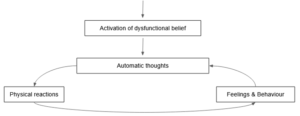
Example of a completed model
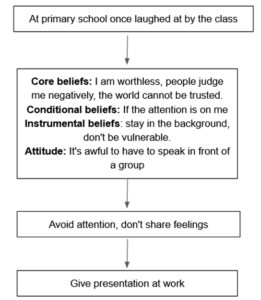
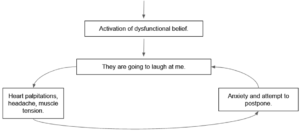
Sources:
Ten Broeke, van der Heiden, Meijer & Hamelink, Cognitieve Therapie de basisvaardigheden, 2008.
Beck, A.T. (1987). Cognitive models of depression. Journal of Cognitive Psychotherapy: An International Quarterly, 1, 5-37.
Which coach are you?
This story is about a youth football team involving various coaches and parents. Johan is one of the youth players. He is a defender and must return the balls that travel towards his team’s goal to the midfield. During a match, the ball is kicked high in his direction. Johan wants to kick the ball back, but misses it completely. This allows the opponent to run freely past him towards the goal and a goal is scored. Johan’s team is now 1-0 behind.
Now, there are a number of different ways a coach can respond. Let’s take coach A and coach B as examples.
- Coach A (emotionally) runs onto the field and shouts: “How can you miss that ball?! Anyone could have stopped that one, even my dog! You ruined it! You can’t do anything right! Next time you will be sitting on the bench!”
- Coach B (motivated) enters the field and says: “Well, you missed that one. Next time, try to remember that high balls seem further away than they are, so try to stand a little further back. Let’s see how it goes next time!”
After Coach A’s reaction, Johan feels very tense; he tries not to cry and hopes that no more balls will be played towards him. Chances are he will miss them anyway because of the tension in his body and the tears in his eyes. After the game, Johan’s parents also notice his frustration. He throws his shoes into a corner, and, before the next match, Johan complains about stomachache.
As you can imagine, Johan feels different after Coach B’s reaction than after Coach A’s reaction. Johan still isn’t happy, because he missed a ball, but he now knows what to do next time a high ball comes towards him.
Which coach do you think Johan’s parents would pick as the best choice for their son? Probably Coach B! Coach B teaches Johan how to be a better player. Because of Coach B, Johan does not get tense and enjoys the game.
Who would you choose?
While we would probably all choose Coach B for Johan, we rarely choose Coach B when it comes to the way we talk to ourselves. Just think about the last ‘mistake’ you made. You probably thought “I am so stupid” or “I am such an idiot”. These are statements that Coach A would use and add tension and worry. Actually, you should try to talk to yourself as Coach B would, especially if you want to enjoy life more and achieve your goals with fulfilment. In difficult situations, try to replace Coach A thoughts with Coach B thoughts! You can read tips on how to do this in the blog article about self-compassion.
Source:
Keijsers, G. P. J., Van Minnen, A., Verbraak, M., Hoogduin, C. A. L. & Emmelkamp, P., (2017). Protocollaire behandelingen voor volwassenen met psychische klachten.Bijlage gedownload van: boompyschologie.nl
What are feelings?
Feelings prepare your body for action and signal that you have a need. For example, you often experience anger because you have a need for justice. Your body sends out a signal as soon as you feel an emotion, such as accelerated breathing and a tingling or a knot in your stomach. Your body is ‘activated’, ensuring that you have the energy and are prepared to change your current situation. If you are in touch with your body, you will be quick to notice these particular sensations. If you don’t feel many emotions, it probably means you’re not paying enough attention to how your body is feeling. You will probably notice that you are regularly suffering from restlessness, or a feeling that you cannot properly identify. This indicates that your emotions are being suppressed. We suppress our emotions in many ways: one person will distract himself, another person will get ‘stuck’ in their head and start worrying.
Feelings during a current addiction
During an active addiction (daily or almost daily use), an addict does not want to feel many emotions. They prefer their emotions to be pushed away or distorted. Because this pattern of behaviour is repeated over a long period of time, an addict teaches himself that he cannot tolerate unpleasant emotions. By doing so, he/she remains addicted and, thus, the negative spiral is maintained.
Feelings during a recovery process
When you stop using an addictive substance or conducting addictive behaviour, the suppressed emotions are able to surface. This can feel bad or uncomfortable in the beginning. Restlessness is the word often used to describe this feeling. At the start of your recovery process, there can be a period during which you feel even worse. This is because you were used to going through life ‘numb’ for a long period of time. Thus, the emotions can feel very intense. During your recovery process, you will learn to look at your emotions from a new perspective and learn how to tolerate them. The longer they are suppressed or numbed, the worse you can feel in the long run. Step by step, you are going to learn to change the way you manage your emotions. You will learn new skills from your professional and put them into practice.
The principles of HALT can help you understand what your emotions are trying to tell you and what your underlying needs are. It is a mnemonic to help remind you of the potential risk of relapse.
HALT
HALT stands for Hungry, Angry, Lonely and Tired. These are risk factors that every addict has to deal with. If you feel hungry, angry, lonely or tired, the threshold for relapsing becomes lower. These feelings can be seen as triggers, which, over time, have become associated with your addiction. Triggers are the thoughts, emotions, circumstances and certain sensations that cause you to experience a craving.
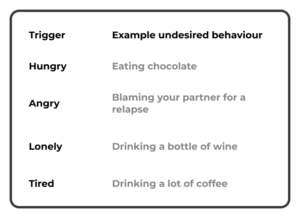
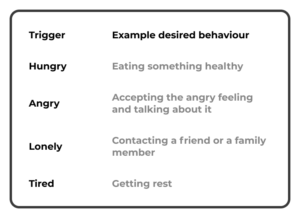
Mapping out triggers
To learn what your triggers are, it is important to map out how and when you experience cravings. You can keep track of when you feel the HALT triggers. Keeping track of your HALT triggers can help you to be alert of the moments you experience them, so that you can avoid a craving.
One of the most important steps is to become aware that there is a strong tendency to ‘use’ when you feel bad or low. The next step is to take good care of yourself to avoid feeling hungry, anxious, lonely, or tired on a regular basis. Improving your daily structure can help you do this.
Remember to be patient with yourself. It takes time to re-learn how to listen to your body’s signals.
Finally, a number of motivational thoughts to conclude this assignment:
- You can learn to accept your emotions and leave them be.
- You are able to change your behaviour.
- You are not your thoughts. You can observe them from a distance and even change them.
Exercise
Write down what your desired behaviours are in regard to the HALT principles.
You have made the decision to quit your addiction. You have told your friends and family and you have signed up for professional help. A great first step! In good spirits you start your recovery process and you are in a so-called “honeymoon period” now that you have quit your addiction for some time now. But suddenly you experience a strong craving and before you know it you have relapsed back into your old addiction patterns. Don’t worry, this happens to everyone.
“It is impossible to live without failing at something, unless you live so cautiously that you might as well not have lived at all – in which case, you fail by default.”- J.K. Rowling
A relapse is part of the process
A relapse doesn’t have to be the end of your recovery process. It is part of the recovery process. At the beginning of your recovery process, you are vulnerable and sensitive to triggers or periods of craving. Discuss this with someone close to you or your professional. This will help you to break the usual pattern and keep you in close contact with your friends and family. Afterwards you can reflect on what caused you to relapse. How can you manage your feelings differently next time? A relapse is then instead a valuable lesson.
Don’t compare yourself to others
It is tempting and above all human to compare yourself to others. However a disadvantage of this is that you often compare yourself to someone else who is “more successful” than you are, at least in your eyes. This creates a feeling of inferiority and the chance of a relapse increases. Try to stay as close to yourself as possible. Don’t see your recovery process as a competition. During your recovery process you will strengthen your social skills and this will take time. Be patient with yourself. Your life is unique and so is your recovery process.
Reflect on the positive steps you have already taken
Take time to consciously reflect on the positive steps you have already taken in your recovery process. You can think of the first time you went to a party sober or the time when you endured a strong craving without using. This will increase your self-esteem and will contribute to a more positive self-image. You can also keep a daily or weekly diary in which you write down what went well.
The importance of a relapse prevention plan
At the start of your treatment, think about how you would resume your recovery process after a possible relapse. You will create a relapse prevention plan together with your professional. In the plan you will answer the questions:
- What are the signals that you are experiencing a craving?
- How can other people identify these signals?
- What do you need to prevent relapse? What do you need to recover from a relapse?
- How can the people close to you help you with a relapse?
After a relapse you can re-evaluate your plan. You will be able to make adjustments due to having gained new insights during the process.
Be inspired by books, podcasts or movies
Some people enjoy identifying with other people’s stories. This gives the feeling that you are not alone. You can also be inspired by the process others have gone through when quitting their addiction. Here are a few suggestions, some of them can only be found in Dutch.
Books
- “Ik ben Loïs en ik drink niet meer” – Loïs Bisschop
- “Kieft”- Michiel van Egmond
- “Stop, het verdriet van een verslaving” – Jessica Broekhuis
- “De verslaving voorbij”- Jan Geurtz
- “Sterker dan ooit”- Brené Brown
Movies
- 28 Days
- Don’t worry, he won’t get far on foot
- Thanks for sharing
- When love is not enough
- Beautiful boy
Podcasts
Source:

